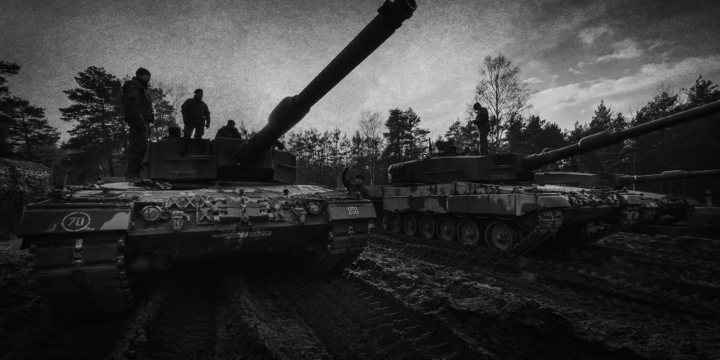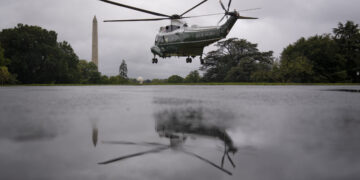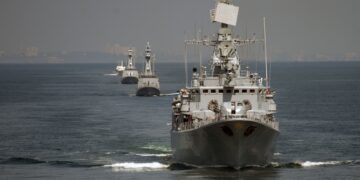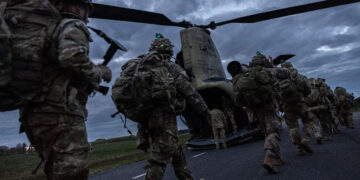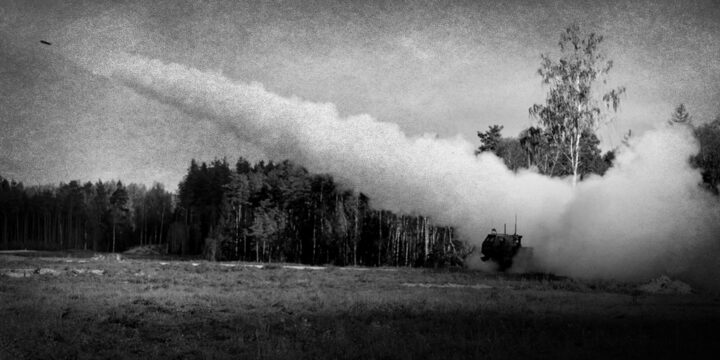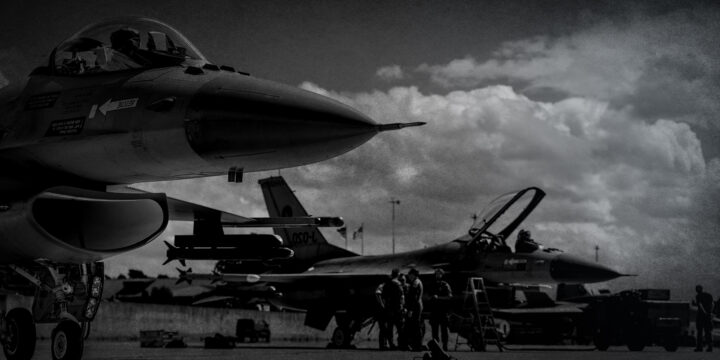February 19, 2022
To prevent war and secure Ukraine, make Ukraine neutral
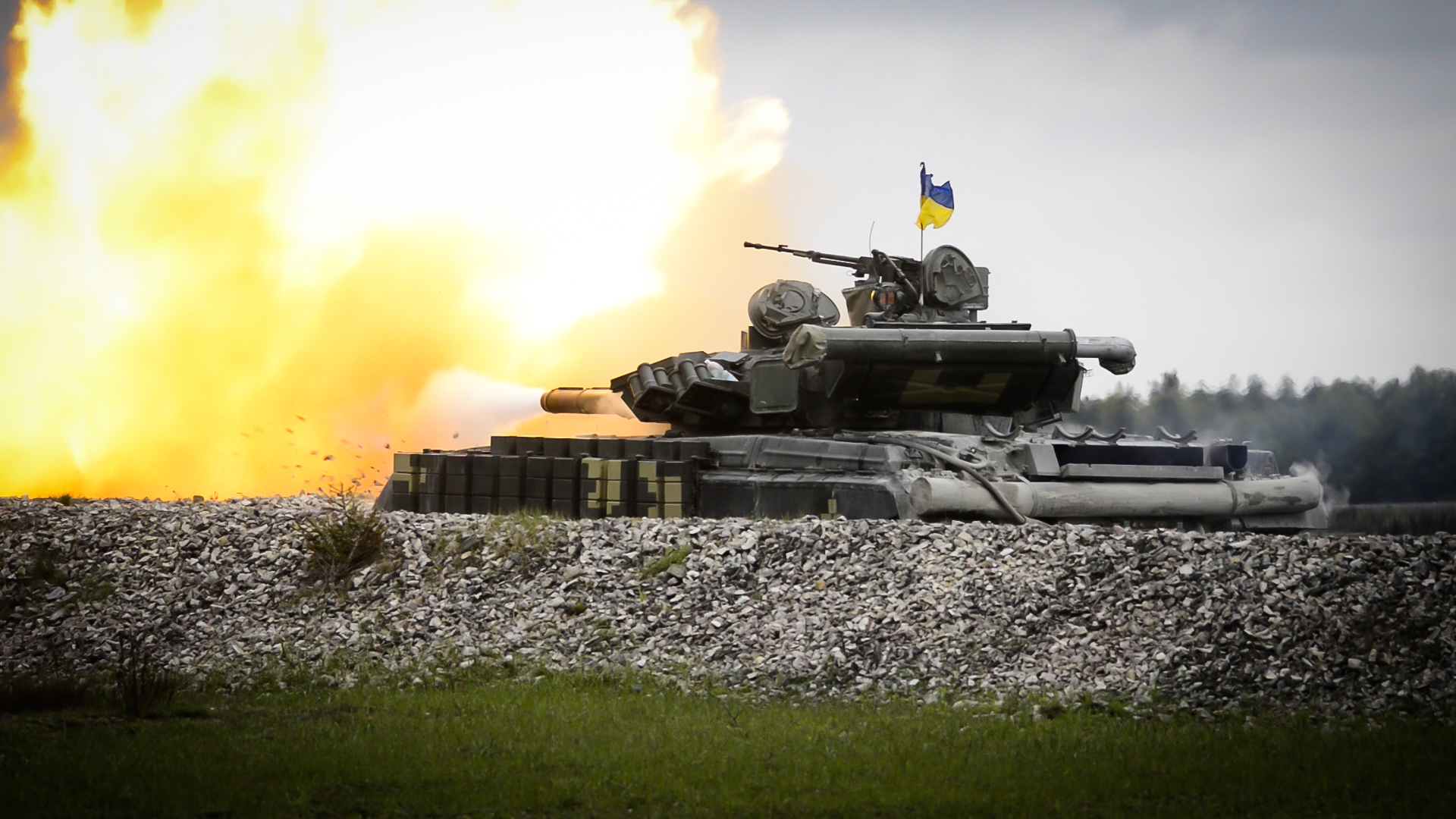
Key points
- The U.S.-NATO-Russia-Ukraine crisis could be resolved by a grand bargain among the parties that defines Ukraine as a neutral state.
- Neutrality deals worked well in the past to forestall Franco-British conflict over Belgium in the 1830s and East-West conflict over Finland and Austria in the Cold War.
- The Belgian, Finnish, and Austrian neutrality deals enhanced the security of the states they made neutral. Neutrality was an asset for Belgium, Finland, and Austria, not a handicap.
- Major powers never calmly accept the close approach to their borders of unfriendly powers or alliances. Russia is no exception. It will not accept a settlement that leaves open the possibility of Ukraine in NATO or NATO in Ukraine. Hence, a neutrality solution is both sufficient and necessary to resolve the current crisis.
- Ukraine is not worth a costly confrontation for the U.S. Hence, U.S. leaders should be open to compromise. If compromise proves elusive, the U.S. should not pay high costs or run large risks to impose a deal on its terms, as it has higher priorities at home and elsewhere.
Neutrality for Ukraine offers an answer
The long-simmering United States conflict with Russia over Ukraine has intensified ominously since late October 2021. Russian President Vladimir Putin has massed some 190,000 Russian troops on Ukraine’s border, while issuing demands in December 2021 that NATO withdraw forces from NATO states in eastern Europe and offer a formal guarantee that Ukraine will never be admitted to NATO. U.S. officials have rejected these demands as non-starters. Negotiations between the United States, its NATO and other partners, and Russia continue but appear at an impasse.
U.S. leaders now warn that a Russian military assault on Ukraine could come at any time.
What U.S. policies are called for? Three considerations should guide the U.S. response.
First, the Ukraine-Russia conflict could be settled by agreement by all relevant parties—Russia, Ukraine, the United States, and NATO—that Ukraine will be a neutral state in world politics. Ukraine would agree to stand neutral between NATO and Russia in all regards. It would undertake no formal alliances or non-defensive military cooperation with either side, and it would defend its borders against any invader. Both Russia and NATO would agree not to disrupt this Ukrainian neutrality, and to otherwise respect Ukraine’s sovereignty.1An agreement on the status of the Donbas in Ukraine will be required for an agreement on Ukrainian neutrality. This seems feasible as solutions to the two issues are mutually enabling. For more on why a settlement of the status of the Donbas in Ukraine and an agreement on Ukrainian neutrality are complementary and can be done together, see Anatol Lieven, “Ukraine: The Most Dangerous Problem in the World,” Nation, November 15, 2021, https://www.thenation.com/article/world/ukraine-donbas-russia-conflict/. Russia and NATO would also agree to cooperate with Ukraine’s efforts at self-defense in ways that pose minimal offensive threat to the other, and to adopt an essentially non-offensive military posture toward Ukraine.2Other endorsements of agreed neutrality as a solution for the Ukraine crisis include Anatol Lieven, “Ukrainian Neutrality: A ‘Golden Bridge’ Out of the Current Geopolitical Trap,” Responsible Statecraft, January 3, 2022, https://responsiblestatecraft.org/2022/01/03/ukrainian-neutrality-golden-bridge-out-of-a-current-geopolitical-trap/; Michael O’Hanlon, “Defusing the Crisis in Europe: A Better Idea for Ukraine than NATO Membership,” Hill, January 10, 2022, https://thehill.com/opinion/national-security/588950-defusing-the-crisis-in-europe-a-better-idea-ukraine-than-nato; and Mike Sweeney, “Saying ‘No’ to NATO–Options for Ukrainian Neutrality,” Defense Priorities, August 12, 2020, https://www.defensepriorities.org/explainers/saying-no-to-nato-options-for-ukrainian-neutrality.
This formula might be called the “Belgium 1830s/Finland Cold War/Austria 1955” solution, reflecting history that suggests it.
- In the 1830s, a British-French struggle for dominion over newly independent Belgium was averted by a British-French-Austrian-Prussian-Russian-Dutch agreement to establish Belgium as a neutral state, framed in treaties in 1831 and 1839. Instead of competing to control Belgium, all agreed that no one would control it.
- In 1948, the Soviet Union and Finland avoided confrontation by agreeing that the Soviets would refrain from meddling in Finland’s internal affairs in return for neutral Finnish behavior in the Cold War.3On Finnish neutrality as a model for Ukraine, see Helena Cobban, “Can ‘Finlandization’ Help Ukraine Stave Off Conflict with Russia?” Responsible Statecraft, December 11, 2019, https://responsiblestatecraft.org/2019/12/11/can-finlandization-help-ukraine-stave-off-conflict-with-russia/.
- In the 1950s, a NATO-Warsaw Pact confrontation over control of Austria was averted by the Austrian State Treaty of 1955 and associated understandings, which committed Austria to be neutral between NATO and the Warsaw Pact, and committed others to respect this Austrian neutrality. In this way a militarized East-West confrontation over Austria, as occurred over Germany, was prevented.4On Austrian neutrality see Franz-Stefan Gady, “Austrian Neutrality: A Model for Ukraine,” National Interest, March 6, 2014, https://nationalinterest.org/commentary/austrian-neutrality-model-ukraine-10005?page=0%2C1; Audrey Kurth Cronin, Great Power Politics and the Struggle for Austria, 1945–1955 (Ithaca: Cornell University Press, 1986).
A parallel solution that establishes Ukraine as neutral while guaranteeing Ukraine’s security would meet NATO’s major goals: ensuring Ukrainian independence, limiting Russian expansion, defusing the current crisis, and reducing the long-term risk of war in eastern Europe. It would also remove the national security threat to Russia–NATO forces on Russia’s 1,200-mile border with Ukraine–that President Putin says is the main concern that animates his belligerence toward Ukraine.
Ukraine should like such a deal, too, as it would secure Ukrainian independence while lowering the risk of Ukraine being drawn into war.
Ukrainian leaders often assume that agreed neutrality handicaps the neutral state in some way, and oppose neutrality for Ukraine for this reason. In fact, however, agreed neutrality is a benefit, not a handicap. It provides a shield against external intervention or coercion and a guard against being entangled in others’ wars. It bolsters national security and national independence. After becoming neutral, Belgium, Austria, and Finland flourished as prosperous, free, and independent societies. Sweden, Switzerland, and Ireland have also prospered in peace and freedom for many decades as neutral states. Agreed neutrality would much improve the political position of Ukraine.
Neutrality for Ukraine is required for an answer
Second, a neutrality deal of some kind is necessary to resolve the current Ukraine crisis. Other solutions will not work, as formulas that omit agreed neutrality for Ukraine would leave open the possibility of NATO forces appearing on Russia’s border, and no Russian leader will accept this.
History shows that states almost universally resist the close approach of unfriendly powers and alliances toward their borders.
The United States has often threatened or used force to keep foreign powers out of the western hemisphere. Instances include:
- The Monroe Doctrine of 1823, which declared that the U.S. would not tolerate European expansion into the Americas.
- U.S. military threats to compel France to drop its efforts to colonize Mexico in 1867, following the U.S. Civil War.
- U.S. interventions in Nicaragua (1909, 1912–1925), Haiti (1915–1934), and the Dominican Republic (1916–1924), launched in part to preempt the appearance of European military bases in Central America and the Caribbean.
- U.S. entry into World War I against Germany, spurred in part by German efforts to enlist Mexico as an ally (and revealed by Britain’s 1917 discovery of the famous Zimmermann telegram to Mexico).
- The 1954 CIA-engineered coup in Guatemala, inspired by (false) U.S. fears that otherwise the Soviet Union might install a Soviet-friendly regime in Guatemala.
- The U.S. threat of war in the 1962 Cuban Missile Crisis in response to Soviet deployment of nuclear forces to Cuba.
- The 1965 U.S. invasion of the Dominican Republic, inspired by (false) U.S. fears that otherwise a Soviet-friendly regime might arise under Dominican President Juan Bosch.
- CIA efforts to prevent the election of Salvador Allende to Chile’s presidency in 1970 and to oust President Allende in 1973, borne in part by (false) fears that he might be subject to Soviet influence.
- U.S. proxy wars in Nicaragua and El Salvador in the 1980s, animated by (exaggerated) U.S. fears that Soviet influence might otherwise appear in the area.
- The 1983 U.S. invasion of Grenada, launched to forestall the unlikely danger that Soviet influence otherwise might appear.
Other states also widely resist the approach of unfriendly powers:
- China attacked U.S. forces in North Korea in November 1950 to prevent the U.S. from establishing a military presence on China’s border, sparking major war.5On the role of the U.S. advance in provoking China’s attack, see Allen S. Whiting, China Crosses the Yalu: The Decision to Enter the Korean War (Stanford: Stanford University Press, 1960): 4–7, 105–6, 127–29, 158–60; Seth Faison, Jr., “Mao’s Cable Explains Drive Into Korea,” New York Times, February 26, 1992, “https://www.nytimes.com/1992/02/26/world/mao-s-cable-explains-drive-into-korea.html; “Mao’s 2 Telegrams on Korea,” New York Times, February 26, 1992, translated and edited by Thomas Christensen. Mao wrote to Stalin on October 2, 1950: “If we allow the United States to occupy all of Korea … the American invaders will run more rampant.” He wrote Zhou Enlai on October 13, 1950: “If we do not send troops, allowing the enemy to press to the Yalu border … it will be most disadvantageous to Manchuria; all of South Manchurian electricity will be threatened. … The harm inflicted by not entering the war would be great.”
- Japan attacked the U.S. in 1941 in part to drive the U.S. from military bases that the U.S. had acquired in Japan’s western Pacific neighborhood in the 1898 Spanish-American war, and which loomed in 1941 over Japanese sea lanes vital to Japan’s access to oil and its war effort in China.
- Israel has long required as a condition for peace that its Arab neighbors agree to demilitarize their territories on its borders.
- German Chancellor Bethmann Hollweg stated in 1914 that Germany sought “security for the German Empire in east and west for the foreseeable future” in World War I by removing French and Russia power from Germany’s borders.6Fritz Fischer, War of Illusions: German Policies from 1911 to 1914 (NY: W.W. Norton, 1975): 536, quoting Bethmann’s “September Program” of September 9, 1914. Bethmann continued: “France must be so weakened as to make its revival as a great power impossible for all time, Russia must be thrust back as far as possible from Germany’s eastern frontier.”
- Pakistan supported the Afghan Taliban’s violent campaign for power in Afghanistan between 1994 and 2021 in order to forestall India from establishing a military presence in what was Pakistan’s main western borderland.7On Pakistan’s motives, see Ahmed Rashid, Descent into Chaos: The U.S. and the Failure of Nation Building in Pakistan, Afghanistan, and Central Asia (New York: Viking, 2008): 25 and passim.
- Czarist Russia long put priority on preventing unfriendly powers from controlling the adjacent Black Sea or the nearby Turkish Straits, and therefore adopted hardline policies toward Turkey in the 1850s and Austria before 1914. These policies helped draw Russia into the 1854–1856 Crimean War and World War I.
In short, governments widely enforce what might be called the “NUPIMBY” principle—“No Unfriendly Powers In My Back Yard.” They react with belligerence to most national security threats; and with special belligerence to threats that appear near their borders. If it is close by, and it looks remotely dangerous, states go bananas. Perhaps such behavior is outdated: in the missile and cyber ages states can inflict great harm from great distance, so strategic depth matters much less, so states should not worry much more about nearby than distant threats. But it is how states think. They are far more neuralgic about nearby threats than those far away. This behavior is a strong empirical regularity.
Implication: the United States will likely provoke resistance if it intrudes its forces or alliances into the backyards of other major powers; hence, it should avoid such intrusions if it wants to avoid conflict with those powers. Regarding Ukraine, the lesson is that Russia will no more accept a NATO presence in Ukraine (or Georgia) than the United States accepted a German-Mexican alliance in 1917; or the United States accepted Soviet missiles in Cuba in 1962; or China accepted a U.S. presence on China’s border with North Korea in 1950; or Japan accepted U.S. bases in the Philippines in 1941; or Pakistan accepted a possible Indian foothold in Afghanistan in 1994–2021.
Discerning U.S. government experts recognized this reality long ago. William J. Burns, U.S. ambassador to Russia between 2005 and 2008 and now CIA director, summarized Russia’s view in a 2008 cable: “Ukrainian entry into NATO is the brightest of all redlines for the Russian elite (not just Putin). … I have yet to find anyone who views Ukraine in NATO as anything other than a direct challenge to Russian interests.”8Joshua Shifrinson and Stephen Wertheim, “Acting too aggressively on Ukraine may endanger it—and Taiwan,” Washington Post, December 23, 2021, https://www.washingtonpost.com/outlook/2021/12/23/ukraine-taiwan-red-lines/. A workable U.S. policy toward Ukraine and Russia must reflect this reality.
U.S. national security is not at stake in Ukraine
Third: While Russian domination of Ukraine would be tragic for Ukrainians, it would pose little threat to U.S. national security. Accordingly, preventing Russia from vassalizing Ukraine is not a vital U.S. national security interest. Hence, the stakes at issue for the United States are not worth a costly confrontation; hence, the United States should be open to compromise solutions that require it as well as Russia to bend. And if Russia does move against Ukraine the United States should respond, but in a restrained fashion that reflects the modest size of the national security stakes at issue. The United States faces much greater danger from other threats and should remain focused on these threats. A costly contest with Russia over Ukraine would be a blunder of misplaced priorities.
Modern states distill their military power from their economic base. Ergo, only states with major-league economies are major powers. By this measure Russia is a minor power, too weak to matter in the great-power game, and far too weak to pose a serious challenge to the United States or its NATO allies. This would remain true if Russia vassalized Ukraine: gaining Ukraine would add very little to Russia’s power.
Russia’s economy produces only 1.74 percent of gross world product (GWP). It ranks eleventh in the world in size, far behind the United States, China, the major NATO states, and Japan. Specifically, Russia’s GDP is a minuscule one-fourteenth the size of the United States’ GDP, only one-tenth the size of China’s GDP, only one-third the size of Japan’s GDP, less than half the GDP of Germany, barely half the GDP of India and France, and less than the GDPs of Italy, South Korea, and Canada.
Together the economies of the 29 non-U.S. NATO states are thirteen times the size of Russia’s economy.
Together the economies of all 30 NATO states are twenty-six times the size of Russia’s economy.
For further perspective: Russia’s GDP is smaller than that of the U.S. state of Texas. Texans are tough but they do not pose a potential threat to the international order.
A combination of Russia and Ukraine would be barely more productive than Russia alone. Ukraine produces a tiny 0.19 percent of GWP, so a combined Russian-plus-Ukrainian economy would produce a mere 1.93 percent of GWP.
Global economic production, 202199Gross world product (GWP) is from “World GDP Ranking 2021 – StatisticsTimes.com,” drawing data from International Monetary Fund World Economic Outlook (October 2021), at https://statisticstimes.com/economy/projected-world-gdp-ranking.php. Data for country GDPs and NATO GDP are from Wikipedia, “List of countries by GDP (nominal)—Wikipedia,” reporting data from the IMF “World Economic Outlook Database, October 2021.” Texas 2021 GDP is from Bureau of Economic Analysis, “Gross Domestic Product by State, 3rd Quarter 2021,” table 3, https://www.bea.gov/news/2021/gross-domestic-product-state-3rd-quarter-2021. All estimates are nominal/exchange rate parity.
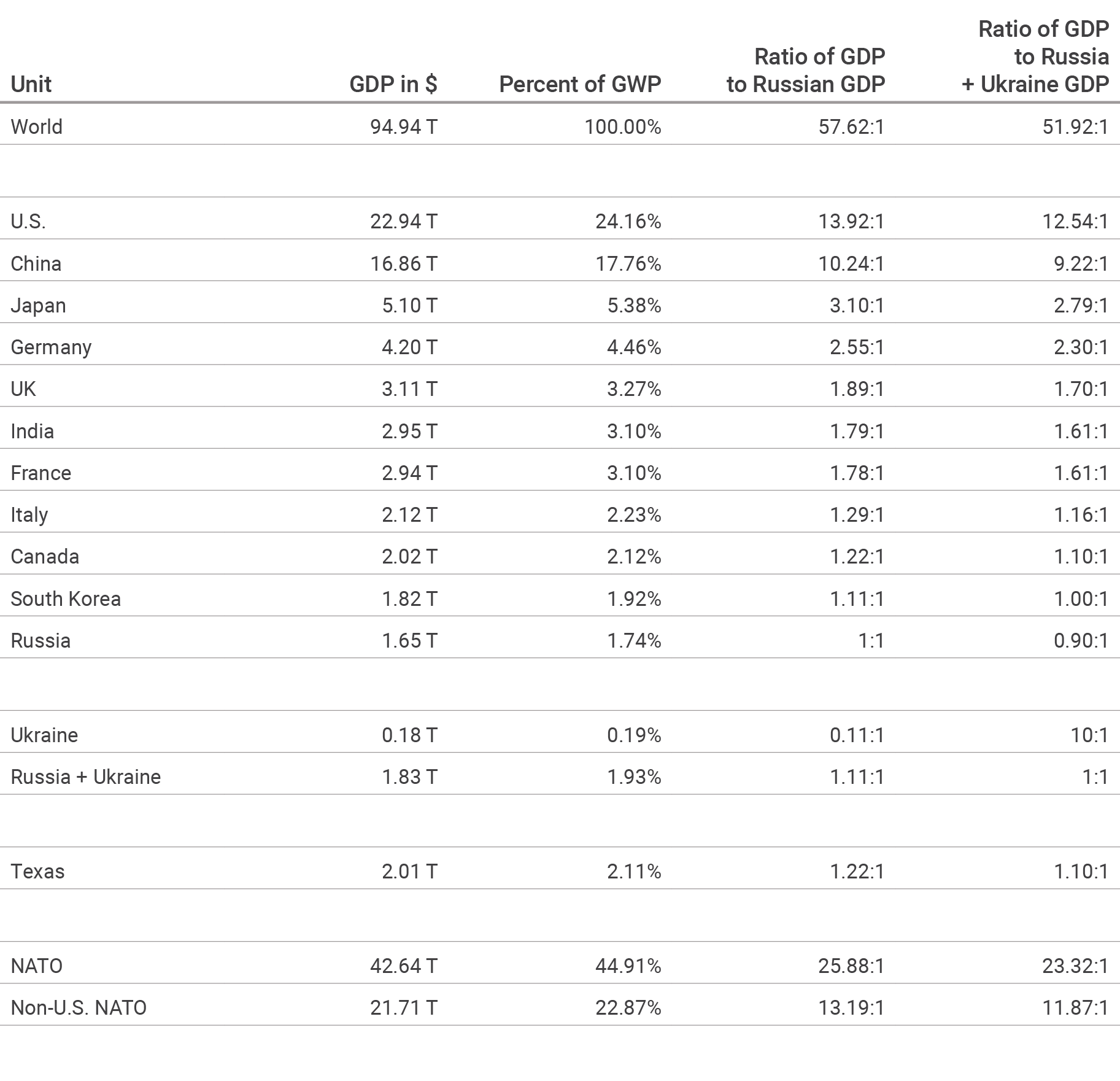
Russia is far too weak to expand except against the weakest of states. It entirely lacks the military potential to challenge the United States, NATO, or other U.S. allies, and would lack such potential even if it combined with Ukraine.
Russia is not a major threat to the U.S.
Real security threats sometimes arise. If so, they must be addressed. In the past the United States faced and addressed arguably real security threats from Wilhelmine Germany (1917–1918), Nazi Germany (1941–1945), and the Soviet Union (1947–1989). A comparison to the current Russian threat gives perspective. The two German regimes and the USSR posed plausible security threats because they were strong enough to pose a plausible challenge for Eurasian hegemony. Each was the largest industrial power in Eurasia at the time, and second largest in the world behind only the United States. Hence, they possessed more military potential than any of their Eurasian competitors. Unchecked the two German regimes and the USSR might, possibly, in a worst case, have conquered an empire with enough economic power to generate a military that could dominate Eurasia, project power across the Atlantic, and threaten the United States, despite the United States’ huge industrial base and vast ocean moats on both sides. In each instance the case that the United States faced a real war-worthy threat was not a slam-dunk, but it had plausibility.
Wilhelmine German, Nazi German, and Soviet shares of GWP
- Wilhelmine Germany in 1913: produced 14.8 percent of world manufacturing output (WMO); or 19.2 percent of WMO in combination with Austria-Hungary.10Paul Kennedy, The Rise and Fall of the Great Powers: Economic Change and Military Conflict from 1500 to 2000 (NY: Random House, 1987): 202. GDPs were not estimated in 1913, but national manufacturing output was estimated and is used here as a proxy for German 1913 GDP.
- The Nazi German empire and its European allies in late 1941: controlled an economic zone that produced roughly 37.3 percent of GWP in 1938.11Estimated from Kennedy, Rise and Fall of the Great Powers: 202; and W.S. and E.S. Woytinsky, World Population and Production (New York: Twentieth Century Fund, 1953): Table 185, 389.
- The Soviet Union and its Warsaw Pact empire in Eastern Europe in 1961–1986: produced approximately 18.7 percent of GWP.12Data from Stephen Van Evera, “The United States and the Third World: When to Intervene?”, Table 4-1, “Shares of Global Product, Selected Years, 1948-1986,” in Kenneth A. Oye, Robert J. Lieber and Donald Rothchild, eds., Eagle in a New World: American Grand Strategy in the Post-Cold War Era (New York: HarperCollins, 1992), 105–150 at 111. The figure 18.7 percent is the average of Soviet shares of GWP in 1961, 1965, 1970, 1975, 1980, and 1986.
Military Potential of Wilhelmine Germany 1913, Nazi Germany 1941, and USSR 1961-86 vs. Russia and Russia + Ukraine, 202113Data in this table is drawn from the previous two tables, “Global Economic Production, 2021,” and “Wilhelmine German, Nazi German and Soviet shares of GWP.” Sources are indicated in footnotes 9, 10, 11, and 12. GDP figures are in trillions of dollars.
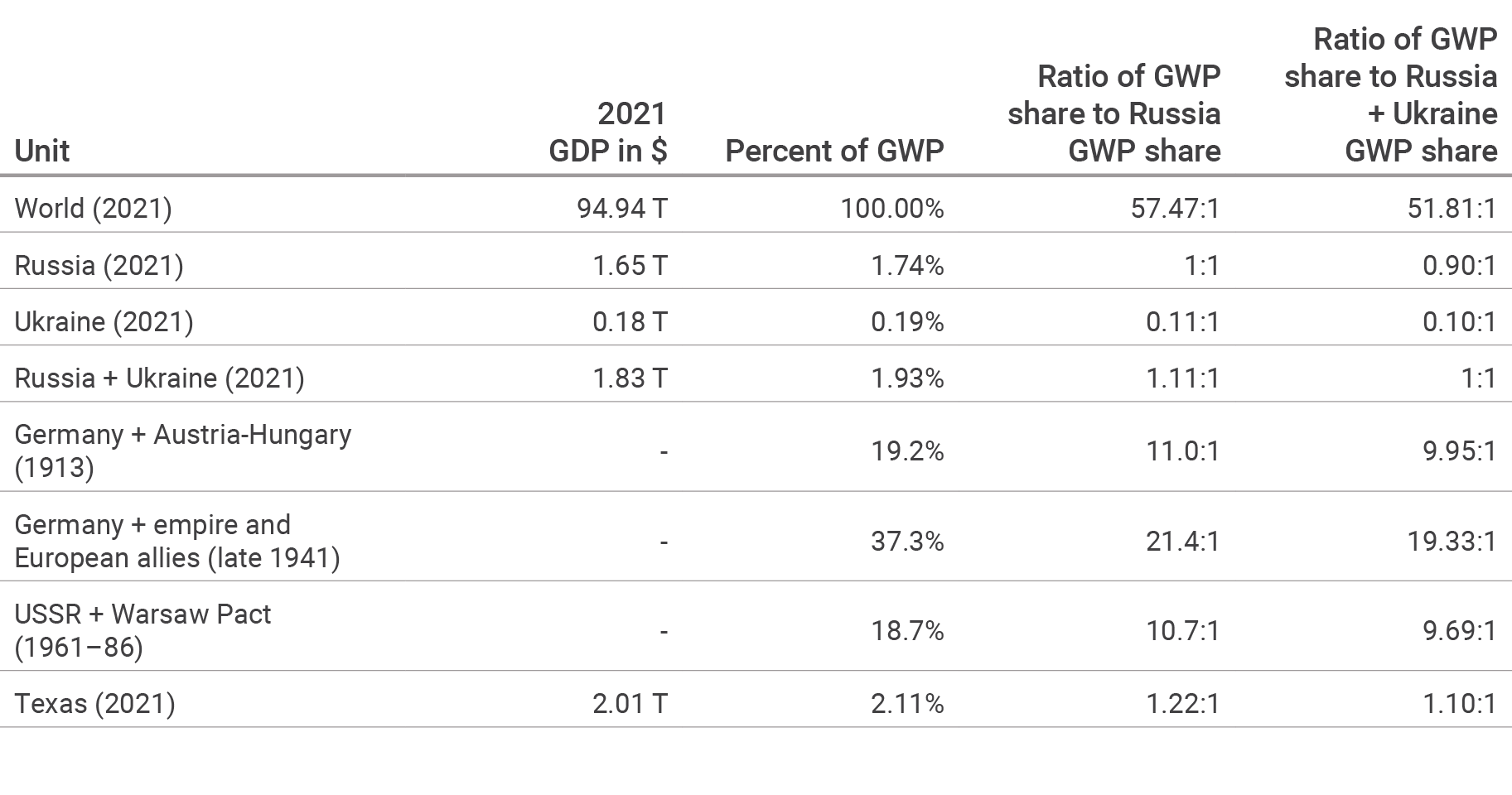
In comparison Russia or Russia-plus-Ukraine today have far less relative military potential than the two German regimes and the USSR. They are not in the same league. The two German regimes and the USSR each produced between 10.7 and 21.4 times the share of gross world product that Russia or Russia-plus-Ukraine produced in 2021. It is a Bambi-vs.-Godzilla contrast. Specifically, in 1913 Wilhelmine Germany plus Austria produced 11 times the share of GWP that Russia produced in 2021; in 1941 the Nazi German empire plus its European allies produced 21.4 times Russia’s 2021 GWP share; and in 1961–1986 the USSR and its East European empire produced 10.7 times Russia’s 2021 GWP share.
Judged by their relative economic bases the threats posed by today’s Russia or a possible Russia-plus-Ukraine combination are vastly smaller than German and Soviet threats Americans deemed plausible in the past.
Let us also recall that the United States now has a large, secure nuclear deterrent, as it did not in 1917 or 1941. This deterrent makes the United States essentially unconquerable, even by a state with far larger GDP, unless that state could somehow convert its GDP advantage into a first-strike nuclear force that could strike U.S. nuclear forces so effectively that they could not inflict unacceptable damage on the attacker in retaliation. Creating such a force would be a very tall order even for an adversary with immense economic superiority over the United States. It is beyond imagining that Russia or Russia-plus-Ukraine could ever pose such a threat.
Ukraine is a top priority for Russia, but it is not for the U.S.
Russia does have the power to reach out and hurt the United States. It has a powerful cyber capacity, which it already uses to attack U.S. elections and incite social conflict in the United States by purveying toxic fake news through social media. Answers must be found to this cyber threat. However, this threat is not elastic to whether Russia does or does not dominate Ukraine. It should be analyzed and addressed on a separate track.
Like the United States, Russia has a large nuclear arsenal, and with it the power to annihilate western (and global) civilization at will, as does any state with a robust nuclear deterrent. The risk of nuclear use rarely appears in NATO-Russian relations. However, it might emerge if the United States and NATO hew to a hard line in a situation—Ukraine–where Russia believes it has more at stake than its adversary, and therefore believes it has greater resolve than its adversaries. Russia might then believe it can win a contest of risk-taking, and hence may risk escalation in expectation that the other will eventually back down in the face of superior Russian resolve, raising the danger of mutual escalation to major war. This is one reason why a NATO-Russian confrontation over Ukraine poses special risks for NATO. President Putin appears to believe that Ukrainian alignment with the West would threaten vital Russian national security interest, and perhaps other vital interests (e.g., cultural). Hence, he may feel he has more at stake in the crisis than the United States and NATO. Hence, he may believe he has superior resolve. Hence, he may think he can win a confrontation by putting his nuclear arsenal in play, as the West, having less resolve, will then back down. Hence, he may look for ways to escalate.
The United States can avoid this scenario by promptly settling the Ukraine crisis on terms that serve the core interests of all parties, e.g., the agreed neutrality of Ukraine.
As a general rule, disputes among nuclear powers are won by the side more willing to run risks and pay costs, hence by the side having greater resolve. Nuclear powers should therefore avoid confrontation with other nuclear powers that have greater resolve than themselves on the issue at hand. U.S. policy in the current crisis should reflect this principle.
Other threats to the United States and NATO are vastly greater than the threat posed by Russia in Ukraine, and they should receive focus. These include weapons of mass destruction terror attacks by Al-Qaeda or other radical Sunni Islamists (whose intentions toward the United States are far more malign than Russia’s); climate change (which threatens far more harm to the United States than any plausible Russian imperial expansion); pandemic and other threats to global public health, which pose large dangers that are best addressed by international cooperation with other powers including Russia (and China), not by conflict with them; terror or insurrection by violent U.S. domestic extremists; China’s rising power (which, as noted, vastly exceeds Russia’s power) and growing belligerence; and Russian cyber-attacks on U.S. elections and U.S. social unity, which threaten much more harm to the United States than possible Russian vassalization of Ukraine. Russian expansion against Ukraine is far down the list. The United States would blunder badly if it diverted its attention from these threats to the Ukraine-Russia issue.
Along with demanding that NATO guarantee that Ukraine will never join it, the Russian president also made a second demand: that NATO refrain from deploying to, and remove forces from, eastern European states that joined NATO after 1997, a group that includes Poland, the Baltic states, and the Balkan states. As with the Russian president’s demands regarding Ukraine, workable compromise formulas to resolve this issue can likely be found. Russia’s statements related to its demand that NATO roll back eastern European force levels indicate that Russia is mainly concerned with the threat these forces pose to Russia. That threat, and also the threat that Russian forces pose to the eastern European NATO states, could be mitigated by a Russia-NATO agreement that both Russia and NATO will adopt essentially defensive military postures toward the other, in line proposals for a “non-offensive defense” (NOD) security order in Europe, as discussed by NATO and Soviet officials in the 1980s.14A discussion of non-offensive defenses is Bjørn Møller and Hakan Wiberg, eds., Non-Offensive Defense for the Twenty-first Century (Abingdon, UK: Routledge, 2020). The concept of non-offensive defense draws on offense-defense theory and a derivative idea, the security dilemma, i.e., a situation where many of the means by which a state tries to increase its security decrease the security of others. The seminal discussion of offense-defense theory and the security dilemma is Robert Jervis, “Cooperation Under the Security Dilemma,” World Politics vol. 30, no. 2 (October 1978): 167–214. A development of offense-defense theory is Stephen Van Evera, Causes of War: Power and the Roots of Conflict (Ithaca NY: Cornell U. Press, 1999): 117–192. A distillation is Stephen Van Evera, “Offense, Defense and the Causes of War,” in Robert J. Art and Kenneth N. Waltz, eds., The Use of Force, 6th ed. (Lanham: Rowman & Littlefield, 2004): 44–69. Such a deal would reduce the threat that forces on both sides pose to the other.
If NATO and Russia can reach agreement on both Ukraine and NATO force levels in eastern Europe, a Russian-NATO modus vivendi will be within reach. Cooperation on other matters of mutual interest, from climate change to global public health to Iranian nuclear weapons, can again be pursued.
U.S. policy should serve U.S. interests
A solution to the current crisis centered on the agreed neutrality of Ukraine will serve the United States’ main goals, and Ukraine’s and Russia’s as well. Solutions that omit Ukrainian neutralization will fail.
The stakes at issue in Ukraine are too small to justify a costly conflict. Hence, finding a compromise to resolve things should take priority; and if compromise proves elusive and Russia uses force, the United States should offer a limited response that reflects the limited size of the U.S. national security stakes at issue.
Continued U.S. insistence on NATO’s right to include Ukraine risks a replay of the outbreak of the U.S.-China war of 1950–1953. That war was sparked by President Harry S. Truman and Secretary of State Dean Acheson’s unwise decision to advance U.S. troops toward China’s border with North Korea despite China’s warnings on October 2 and 3, 1950, not to do so. Whether reasonable or not, Russia has issued a similar warning regarding Ukraine. Disregarding such warnings should only be done for large reasons. They are absent here.
At a glance, Russia looks strong. It has impressive-looking weapons—sleek war planes and big tanks. And it looks big on a map, especially Siberia. But national security policy should look past the surface to measure threats with care and set priorities accordingly. Addressing lesser threats while neglecting larger ones is a grave mistake. And consideration of basics reveals that Russia is a second-rate power that poses a third-order threat and so merits only third-order policy priority for the United States.15A Russian invasion force could probably defeat Ukraine’s regular military forces and the anti-Russian Ukrainian insurgency that would likely appear post-invasion. Thus, Russia can subdue Ukraine, at least in the short run. See Barry Posen, “Ukraine: Unleashing the Rhetorical Dogs of War,” Just Security, February 14, 2022. https://www.justsecurity.org/80230/ukraine-unleashing-the-rhetorical-dogs-of-war/. What Russia lacks is the power to extend its dominion much further west or overseas against determined NATO opposition. To run large risks over Russia’s policy toward Ukraine would be to pursue false priorities. The notion recalls Athens’ disastrous military expedition to Syracuse in the Peloponnesian War, when focusing on larger threats nearby would have far better protected Athens’ security. Running large risks over Ukraine would be a similar error.
Biden administration officials have indicated that they oppose an agreement to make Ukraine neutral on grounds that states have a sovereign right to choose their own allies, and a deal to agree on Ukrainian neutrality would infringe Ukraine’s exercise of this sovereign right. This alleged right is a new principle, not grounded in the U.N. charter, the 1949 NATO treaty, other international law, or past U.S. foreign policy thinking.16Michael O’Hanlon and Stephen Van Evera, “There Is No NATO Open-Door Policy,” Hill, January 27, 2022, https://thehill.com/opinion/national-security/591448-there-is-no-nato-open-door-policy. Some U.S. officials have also asserted the existence of a new international norm that forbids the claiming of spheres of influence by states. They have further implied that the United States observes this norm, and complained that Russia’s demands regarding Ukraine and Eastern Europe violate it. Noting that the U.S. has never observed such a norm is Peter Beinart, “When Will the U.S. Stop Lying to Itself About Global Politics?” New York Times, January 13, 2022, https://www.nytimes.com/2022/01/13/opinion/us-russia-putin-ukraine.html. It serves no U.S. national interest. It should be dropped from U.S. discussion of U.S. policy toward Ukraine-Russia to open space for an agreed-neutrality solution that will serve the core interests of the United States and Ukraine.
Endnotes
- 1An agreement on the status of the Donbas in Ukraine will be required for an agreement on Ukrainian neutrality. This seems feasible as solutions to the two issues are mutually enabling. For more on why a settlement of the status of the Donbas in Ukraine and an agreement on Ukrainian neutrality are complementary and can be done together, see Anatol Lieven, “Ukraine: The Most Dangerous Problem in the World,” Nation, November 15, 2021, https://www.thenation.com/article/world/ukraine-donbas-russia-conflict/.
- 2Other endorsements of agreed neutrality as a solution for the Ukraine crisis include Anatol Lieven, “Ukrainian Neutrality: A ‘Golden Bridge’ Out of the Current Geopolitical Trap,” Responsible Statecraft, January 3, 2022, https://responsiblestatecraft.org/2022/01/03/ukrainian-neutrality-golden-bridge-out-of-a-current-geopolitical-trap/; Michael O’Hanlon, “Defusing the Crisis in Europe: A Better Idea for Ukraine than NATO Membership,” Hill, January 10, 2022, https://thehill.com/opinion/national-security/588950-defusing-the-crisis-in-europe-a-better-idea-ukraine-than-nato; and Mike Sweeney, “Saying ‘No’ to NATO–Options for Ukrainian Neutrality,” Defense Priorities, August 12, 2020, https://www.defensepriorities.org/explainers/saying-no-to-nato-options-for-ukrainian-neutrality.
- 3On Finnish neutrality as a model for Ukraine, see Helena Cobban, “Can ‘Finlandization’ Help Ukraine Stave Off Conflict with Russia?” Responsible Statecraft, December 11, 2019, https://responsiblestatecraft.org/2019/12/11/can-finlandization-help-ukraine-stave-off-conflict-with-russia/.
- 4On Austrian neutrality see Franz-Stefan Gady, “Austrian Neutrality: A Model for Ukraine,” National Interest, March 6, 2014, https://nationalinterest.org/commentary/austrian-neutrality-model-ukraine-10005?page=0%2C1; Audrey Kurth Cronin, Great Power Politics and the Struggle for Austria, 1945–1955 (Ithaca: Cornell University Press, 1986).
- 5On the role of the U.S. advance in provoking China’s attack, see Allen S. Whiting, China Crosses the Yalu: The Decision to Enter the Korean War (Stanford: Stanford University Press, 1960): 4–7, 105–6, 127–29, 158–60; Seth Faison, Jr., “Mao’s Cable Explains Drive Into Korea,” New York Times, February 26, 1992, “https://www.nytimes.com/1992/02/26/world/mao-s-cable-explains-drive-into-korea.html; “Mao’s 2 Telegrams on Korea,” New York Times, February 26, 1992, translated and edited by Thomas Christensen. Mao wrote to Stalin on October 2, 1950: “If we allow the United States to occupy all of Korea … the American invaders will run more rampant.” He wrote Zhou Enlai on October 13, 1950: “If we do not send troops, allowing the enemy to press to the Yalu border … it will be most disadvantageous to Manchuria; all of South Manchurian electricity will be threatened. … The harm inflicted by not entering the war would be great.”
- 6Fritz Fischer, War of Illusions: German Policies from 1911 to 1914 (NY: W.W. Norton, 1975): 536, quoting Bethmann’s “September Program” of September 9, 1914. Bethmann continued: “France must be so weakened as to make its revival as a great power impossible for all time, Russia must be thrust back as far as possible from Germany’s eastern frontier.”
- 7On Pakistan’s motives, see Ahmed Rashid, Descent into Chaos: The U.S. and the Failure of Nation Building in Pakistan, Afghanistan, and Central Asia (New York: Viking, 2008): 25 and passim.
- 8Joshua Shifrinson and Stephen Wertheim, “Acting too aggressively on Ukraine may endanger it—and Taiwan,” Washington Post, December 23, 2021, https://www.washingtonpost.com/outlook/2021/12/23/ukraine-taiwan-red-lines/.
- 9Gross world product (GWP) is from “World GDP Ranking 2021 – StatisticsTimes.com,” drawing data from International Monetary Fund World Economic Outlook (October 2021), at https://statisticstimes.com/economy/projected-world-gdp-ranking.php. Data for country GDPs and NATO GDP are from Wikipedia, “List of countries by GDP (nominal)—Wikipedia,” reporting data from the IMF “World Economic Outlook Database, October 2021.” Texas 2021 GDP is from Bureau of Economic Analysis, “Gross Domestic Product by State, 3rd Quarter 2021,” table 3, https://www.bea.gov/news/2021/gross-domestic-product-state-3rd-quarter-2021. All estimates are nominal/exchange rate parity.
- 10Paul Kennedy, The Rise and Fall of the Great Powers: Economic Change and Military Conflict from 1500 to 2000 (NY: Random House, 1987): 202. GDPs were not estimated in 1913, but national manufacturing output was estimated and is used here as a proxy for German 1913 GDP.
- 11Estimated from Kennedy, Rise and Fall of the Great Powers: 202; and W.S. and E.S. Woytinsky, World Population and Production (New York: Twentieth Century Fund, 1953): Table 185, 389.
- 12Data from Stephen Van Evera, “The United States and the Third World: When to Intervene?”, Table 4-1, “Shares of Global Product, Selected Years, 1948-1986,” in Kenneth A. Oye, Robert J. Lieber and Donald Rothchild, eds., Eagle in a New World: American Grand Strategy in the Post-Cold War Era (New York: HarperCollins, 1992), 105–150 at 111. The figure 18.7 percent is the average of Soviet shares of GWP in 1961, 1965, 1970, 1975, 1980, and 1986.
- 13Data in this table is drawn from the previous two tables, “Global Economic Production, 2021,” and “Wilhelmine German, Nazi German and Soviet shares of GWP.” Sources are indicated in footnotes 9, 10, 11, and 12. GDP figures are in trillions of dollars.
- 14A discussion of non-offensive defenses is Bjørn Møller and Hakan Wiberg, eds., Non-Offensive Defense for the Twenty-first Century (Abingdon, UK: Routledge, 2020). The concept of non-offensive defense draws on offense-defense theory and a derivative idea, the security dilemma, i.e., a situation where many of the means by which a state tries to increase its security decrease the security of others. The seminal discussion of offense-defense theory and the security dilemma is Robert Jervis, “Cooperation Under the Security Dilemma,” World Politics vol. 30, no. 2 (October 1978): 167–214. A development of offense-defense theory is Stephen Van Evera, Causes of War: Power and the Roots of Conflict (Ithaca NY: Cornell U. Press, 1999): 117–192. A distillation is Stephen Van Evera, “Offense, Defense and the Causes of War,” in Robert J. Art and Kenneth N. Waltz, eds., The Use of Force, 6th ed. (Lanham: Rowman & Littlefield, 2004): 44–69.
- 15A Russian invasion force could probably defeat Ukraine’s regular military forces and the anti-Russian Ukrainian insurgency that would likely appear post-invasion. Thus, Russia can subdue Ukraine, at least in the short run. See Barry Posen, “Ukraine: Unleashing the Rhetorical Dogs of War,” Just Security, February 14, 2022. https://www.justsecurity.org/80230/ukraine-unleashing-the-rhetorical-dogs-of-war/. What Russia lacks is the power to extend its dominion much further west or overseas against determined NATO opposition.
- 16Michael O’Hanlon and Stephen Van Evera, “There Is No NATO Open-Door Policy,” Hill, January 27, 2022, https://thehill.com/opinion/national-security/591448-there-is-no-nato-open-door-policy. Some U.S. officials have also asserted the existence of a new international norm that forbids the claiming of spheres of influence by states. They have further implied that the United States observes this norm, and complained that Russia’s demands regarding Ukraine and Eastern Europe violate it. Noting that the U.S. has never observed such a norm is Peter Beinart, “When Will the U.S. Stop Lying to Itself About Global Politics?” New York Times, January 13, 2022, https://www.nytimes.com/2022/01/13/opinion/us-russia-putin-ukraine.html.
Author

Stephen
Van Evera
Ford International Professor of Political Science
Massachusetts Institute of Technology
More on Eurasia
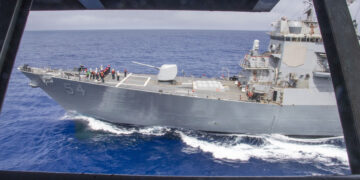
By John Mueller
April 10, 2025

Featuring Lyle Goldstein
April 1, 2025
Events on Ukraine-Russia
